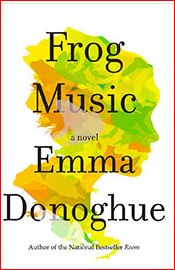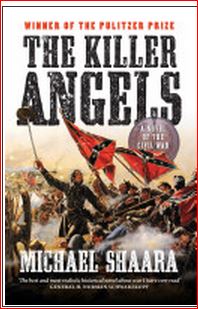REIMAGINING THE MOMENT
3/04/2015 – REIMAGINING THE MOMENT
I’ve just finished reading two novels that re-envision a few days out of history, one about a famous battle, the other an obscure murder. Both novels include meticulously researched historical details, stretched here and there to fit the arc of a story and perhaps highlight a deeper truth, but still leaving readers with a fresh sense of worlds long vanished. More than that, though, both  novels reminded me of the infinite richness in the smallness, shortest of moments, something all writers should remember.
novels reminded me of the infinite richness in the smallness, shortest of moments, something all writers should remember.
The first novel, Emma Donoghue’s Frog Music, takes place in San Francisco during the summer of 1876 when the city is in the grip of a smallpox epidemic and heatwave, Donohue reimagines the backstory behind the mysterious murder of a young woman named Jenny Bonnet, which the author has meticulously documented by spending over a decade hunting up old articles, songs, census records, and chronicles. Virtually all the characters in the story are real historical figures, with the exception of a handful of bit players who are named in the Afterword.
Michael Shaara’s Pulitzer Prize winning novel The Killer Angels takes place over just four days and tells the story of the Battle of Gettysburg from the perspective of various protagonists, all of them real-life figures. Unlike the characters in Frog Music, many of these characters are well known to anyone who went to grade school in the USA, as are the events and significance of the battle. Like Frog Music, this novel was the product of careful research, particularly the memoirs of General James Longstreet. Since its publication in 1974, it continues to be held up as a realistic and influential historical novel and is even required reading for many military leaders in training.
As works of fiction, both of these works are powerful. Both evoke the haunting sense that comes of knowing what is going to happen and yet realizing you don’t know anything worth knowing. Even if you remember the details of the Battle of Gettysburg, you have absolutely no idea what is going to happen from moment to moment in Killer Angels, for example, or, more to the point, exactly how it is going to happen. You might know that when Major General Reynolds climbs on his horse he is about to ride off to his death. And yet, at that instant of reading, he is still very much living and breathing, and you cherish that soon-to-be-vanished moment all the more because you know it soon will end. More, you feel like you’re about to get some privileged insight into a just what Reynolds did and felt right before that fatal moment, glimpses that no one has ever had before.
And yet these privileged moments, the best parts of the books, are creations of the imagination. Such fabrication poses a problem for some academic historians. Historical novels and other popularized versions of history, even when written by prominent academics, are often dismissed as hagiographies or criticized for emphasizing narrative and portraiture, or sermonizing, oversimplifying, and even shaping facts to fit theories (all common foibles of many professional historians as well, but that’s another matter altogether). They are also criticized for pandering to popular tastes rather than filling voids in the academic literature.
Some of this dismissal can be chalked up to simple jealousy, since people writing novels or mass market histories get a lot more attention, critical acclaim, and, sometimes, monetary compensation than their counterparts who stick strictly to the Ivory Tower. However, in novels like Frog Music or Killer Angels, which focus on a few select individuals and a few days or weeks, rather than covering entire epochs or swaths of society, these concerns may be worth considering. History plays are even more problematic, forced to condense entire wars or reigns into a few hours. Here it may be more reasonable to question whether it’s possible to derive historical truth from pulling a brief moment out of time and re-envisioning it under a fictional lens – particularly when you consider that for many people these works of fiction may be the only, or most lingering, source of historical knowledge.
What doesn’t seem to be as recognized in these discussions, however, are the similarities between the novelist’s quest and the historian’s. History is sometimes said to be the tale told by the victor. It is also a tale told and re-told by different historians, in different generations, shaped by the personal and social background of the teller rather than representing a single, unchanging truth. Some of these tales (and they are “tales,” however well-credentialed the teller) may be more factually “accurate” than others, and some may seem more or less so over the course of time. However, taken together, the many accounts of any moment in time add up, overlap, and, sometimes, cancel each other out to tell what may be a clearer, fuller picture of what actually happened, just as in Akira Kurosawa’s masterpiece Rashomon seven different people have seven completely different versions of the same event.
The novelist has a key place in this process because a good historical novelist adds an element that professional historians tend (or pretend) to eschew: imagination. Within any given period of time, no matter how much we know, is an infinite number of things we do not, and never will. Here is where a novelist’s own imagination is given free play, and where the ground opens up for new insights into a moment in time that a historian alone may never see no matter how many documents he pours over.
Historical dramatists may be in an even better position here, despite their paradoxically more stringent limitations. Noting that truth is more complicated than facts, for example, Robert Schenkkan, the author of All the Way, has observed that by stretching a story beyond the bounds of mere fact, a playwright is given extraordinary power to create deeper truths. In a recent article in The Dramatist (Sep/Oct 2014), he describes his discovery of two seemingly unrelated events that occurred during the same 24-hour period: the bodies of three murdered Civil Rights workers unearthed from a Mississippi dam and a decision by President Lyndon Baines Johnson about the Gulf of Tonkin crisis that triggered the country’s “descent down the steep and slippery slope of Vietnam.” By portraying both events simultaneously on stage in a way that obviously never occurred in real life, Schenkkan as a playwright not only had the power to heighten this moment but to highlight very real but otherwise hidden connections.
Good historians already know that every moment is not only still very much alive but that it is infinitely divisible, and infinitely describable. Historical works of the imagination expand the ways it can be divided and described because in every grain of time is an infinity of perspectives. There is therefore no limit to the number of fictional re-tellings of a past moment, and all of them can be just as potentially true. That is why not just historians but also novelists (and playwrights, and poets, and, even, for that matter, visual artists and composers) can keep going back to that same eternal grain of time and see new worlds in it. That world may appear to be finished from the myopic perspective of today, but it turns out to be infinitely changing and full of possibility when we re-imagine
The other thing fiction can do with a seemingly finished moment in time is magically keep it alive and ever-changing. Historical works of the imagination remind us that what is past is never really past, and that every moment that ever was can be relived, and re-experienced, every after, and re-lived and re-experienced in newborn ways. They remind us, as one of my characters observed in my novel Permanent Makeup, “that all that ever was always is.”
Terra Ziporyn
TERRA ZIPORYN is an award-winning novelist, playwright, and science writer whose numerous popular health and medical publications include The New Harvard Guide to Women’s Health, Nameless Diseases, and Alternative Medicine for Dummies. Her novels include Do Not Go Gentle, The Bliss of Solitude, and Time’s Fool, which in 2008 was awarded first prize for historical fiction by the Maryland Writers Association. Terra has participated in both the Bread Loaf Writers Conference and the Old Chatham Writers Conference and for many years was a member of Theatre Building Chicago’s Writers Workshop (New Tuners). A former associate editor of the Journal of the American Medical Association (JAMA), she has a PhD in the history of science and medicine from the University of Chicago and a BA in both history and biology from Yale University, where she also studied playwriting with Ted Tally. Her latest novel, Permanent Makeup, is available in paperback and as a Kindle Select Book.
- Web |
- More Posts(106)